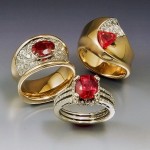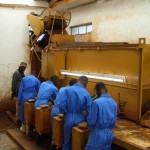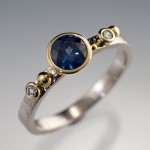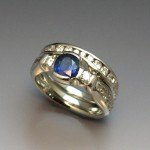“To be an artist is a good and generous act.”
Cay Lang, Taking the Leap: Building a Career as a Visual Artist

“To be an artist is a good and generous act.”
Cay Lang, Taking the Leap: Building a Career as a Visual Artist
“Fear that you are not a real artist causes you to undervalue your work.”
Art & Fear by David Bayles and Ted Orland
 Simple Soldering: A Beginner’s Guide to Jewelry Making, Kate Ferrant Richbourg, Interweave Press, 2012. 159 pages, color, includes instructional DVD. $29.95
Simple Soldering: A Beginner’s Guide to Jewelry Making, Kate Ferrant Richbourg, Interweave Press, 2012. 159 pages, color, includes instructional DVD. $29.95
If you’re interested in making jewelry or taking your jewelry skills to the next level, Kate Richbourg’s Simple Soldering is a good place to start. She assumes her readers are starting without any background in metal work, so the first four chapters provide a soldering overview, a guide to setting up a work space, vital safety considerations (after all, a torch flame and red-hot metal are nothing to be careless with!), and an introduction to tools and materials necessary to the craft. The impatient (i.e., me) may be tempted to skip these chapters, but don’t. Richbourg provides lots of good information that will make your progress much smoother and your learning much more successful.
The first chapter where you get your hands dirty (literally: copper can be dirty to work with) is filled with 16 small projects that teach you all the skills you need to use in the remaining projects. Richbourg designs these projects as a sampler, reminiscent of the needlework samplers of earlier days when needlework was an invaluable and highly valued skill. Completing this sampler, too, will give you invaluable skills. So despite the fact that you will not have a finished piece of jewelry when you have completed these projects, they are vital. Richbourg wants you to be able to work without regard to the finished piece, instead focusing all your attention on learning about the materials, how to handle the tools, getting familiar with the process, and–very important–how to fix an oops when you have one (and you will).
The following 20 projects are organized so that you use increasingly more challenging techniques and combinations of techniques–and of course, each results in a much more satisfying piece of jewelry.
On the DVD, Richbourg has a very clear and pleasant presentation style. The visuals are excellent. However, though there is a presentation of the tools you’ll need, and sections on some of the more complex techniques, there is no demonstration of basic things, such as sawing and filing. True, this is a book/DVD about soldering, not metal working in general. But because the book is designed for complete beginners, the DVD would have been a great place to walk users through each piece of the sampler so there would be a visual guide to each technique.
I also wish that Interweave had used a binding type that would lie flat or, even better, fold back on itself (such as a spiral binding) so that a reader would not have to weight the book open on the bench.
That said, though, I think anyone wanting to learn soldering on their own, would be very pleased with what they can learn in this book. You can try this at home!
Jewellery in Israel: Multicultural Diversity 1948 to the Present
In Jewellery in Israel: Multicultural Diversity, 1948 to the Present, art historian, Iris Fishof, writes “Jewellery can reflect the history of the society of which it is a part.” She uses this idea as a lens to examine the influence of immigration on her country’s jewelry design heritage, as Israel is a nation of immigrants.
Fishof sets the stage in the first chapter, “Prelude: Jewellery in Pre-State Israel,” which traces Israeli jewelry to the earliest “souvenir” jewelry made by Muslim artists in the region primarily for Christian pilgrims to Jerusalem. She explains that as Zionism–the movement to establish a Jewish state in Israel—was established in the early years of the 20th century, it included the intention to create an arts and crafts school as part of the effort to develop an Israeli identity. This became the Bezalel School of Arts and Crafts which, through many name and leadership changes, was to have a great and continuing impact on the jewelry of Israel.
At the beginning the school focused on developing a “Hebrew” style, which included design motifs such as the Hebrew alphabet, Jewish symbols, biblical scenes, and the flora, fauna and sites of the Holy Land. But as the rise of the Nazis during the 1930s led to the first wave of European immigrants, the work of German metalsmiths, steeped in modernism and the Bauhaus philosophy of unadorned simplicity, began to have a significant impact. Their influence on the Israeli style would last for the next 30 or more years.
After World War II and the establishment of the state of Israel, Jewish immigrants from all over the world found their way to Israel, doubling the region’s population. “The Melting Pot: 1950s to 1970s,” describes how Jewish immigrants, at first urged to give up their cultural identity in favor of an Israeli one, struggled to make a living from the harsh land. During this period, immigrants from Yemen, with centuries of traditional Islamic jewelry design influence behind them, had a strong and lasting impact on the jewelry of Israel. Because the ethnicity of the jewelry was not marketable to women of the time, Fishof describes how jewelry made by Yemeni craftsmen, would be “adjusted to the demands and tastes of modern women by other craftsmen.” Essentially, the pieces were taken apart and reassembled into something more contemporary. One of the first designers to make contemporary jewelry that echoed traditional styles without the use of traditionally made components was Finy Leitersdorf. Her use of desert-worn glass fragments in her designs would presage the use of non-precious metals in the designer jewelry that followed.
In the 1960s, as Israel moved from “Isolation to Exposure” (Chapter 3) in terms of jewelry, Israeli designers who had studied abroad and foreign designers who came to Israel to teach brought in new influences. Israeli designers began experimenting with different styles and materials, integrating them into the Israeli design esthetic that had been developing in isolation for twenty or more years.
It’s at this point that artist jewelers began to have a large impact on Israeli jewelry design and the influence of the Bauhaus began to fade. It is also at this point the emphasis in Fishof’s book moves away from the effect of multicultural diversity and immigration on Israeli jewelry. Chapter 4, “International Recognition,” focuses on the work and background of four Israeli artist jewelers whose work was recognized outside of Israel– Bianca Eshel Gershuni, Vered Kaminski, Esther Knobel, and Deganit Stern Schocken—who were either born in Israel or immigrated with their parents at a very young age. As these women became instructors at Bezalel, their work has a continuing impact on emerging Israeli artists
In the final chapter, “The Contemporary Scene,” Fishof brings us to the present, and demonstrates how far Israeli jewelry has come from the “Hebrew style” of the early Bezalel School of Art and Crafts. Yet many influences are still there, particularly in the use of botanical and religious images, although these are often more abstract than the originals. There are pieces based on motifs from rural regions of Israel as well as those from urban areas. The work is often narrative, meant to tell or comment on personal or family stories, such as a necklace by Knobel from the previous chapter, entitled Pine Tree Needles, which Fishof writes is “shaped like the actual pine needle necklaces habitually made by children in Israel.” As Israel is a country that has spent the last 70-plus years forging an identity in a climate of recurrent war, there are numerous pieces incorporating the topic of war, either of survival or protest.
Like many other artist jewelers from around the world at this time period, the work of work of contemporary jewelry artists include non-precious materials as well as precious ones. In Israeli jewelry, non-precious materials may include broken tiles, stones, protective steel mesh, or crushed beverage cans from Israel.
One of the questions Fishof asks in her final chapter is “Is there a concept such as Israeli jewelry?” She concludes that there is. On my first reading, I felt I disagreed with her: many art jewelry designers today use less expensive or even throwaway materials, use elements from their surroundings, and tell personal and even painful narratives. But on a second reading, I changed my mind. What else can better make up a national design concept than images, colors, and materials taken from the artist’s surroundings and drawn from their cultural and/or artistic heritage?
Any book such as this that documents the jewelry history of a people must be well illustrated in order to demonstrate the points the author is making. A difficult task, yet “Jewellery in Israel: Multicultural Diversity 1948 to the Present,” richly illustrated with black and white images as well as color—many of them full page–does an excellent job of helping the author make her points clear.
At a few points, the history telling is a bit choppy. For example, in the first chapter, the Yemeni silversmiths are mentioned, leading the reader to believe they were part of the pre-state jewelry manufacturing in Israel. Only in the second chapter do we learn that most Yemeni artists immigrated to Israel in the 1940s after Israel became a state. Some of the difficulties with the narrative flow, however, may be due to the book’s migration through translation.
I would have been interested to learn what, if any, influence Palestinian work might have on Israeli jewelry design. Fishof mentions the effect the ongoing conflict has on the narrative in the jewelry but doesn’t mention whether there is design influence as well. Fishof also mentions the recent influx of African immigrants. It may be too early to know what influence African jewelry makers may bring to the art of Israeli jewelry.
All in all, a very recommended read for anyone interested in ethnic jewelry or contemporary art jewelry from a country whose impact in jewelry design is greater than the size of the country and the length of its history might suggest.
This review first appeared in Gems & Gemology.

14k gold rings, set with diamonds and fair trade Nyala rubies from Malawi, sourced by Columbia Gem House. Photo courtesy Trios Studio, Lake Oswego, OR.
The story of colored gems is not always a pretty one. At the mining and manufacturing end there is environmental degradation, child labor, death from silicosis, low wages, dangerous working conditions. For wholesalers, retailers, and consumers, an uncontrolled supply chain can allow treated, adulterated, imitation, and synthetic materials to masquerade as naturals, creating distrust among buyers and lawsuits against suppliers.
These situations are well known to consumers—especially the millions of socially and environmentally aware “Millennials” born in the final decades of the 20th century–through television documentaries and the Internet. Projected to have the greatest impact on consumerism since the post-war Baby Boomers, this demographic wants the same global and community awareness from those who provide their products. They already pay a premium for responsibly sourced products, such as coffee, chocolate, and beauty products.

18kw gold ring set with light green, untreated, Montana sapphire, approx. 0.60ct. Designers often focus on gems produced by domestic artisanal gem miners, such as Montana sapphires. Photo courtesy Nodeform.
As a result of the above–a desire to do “the right thing” for the environment and gem workers; to ensure the quality of the supply chain; to protect consumers against deception and themselves against lawsuits and tarnished reputations; and the demands of a rising market–a slowly a growing segment of the jewelry industry is turning toward fair trade or responsible sourcing in gold, diamonds and colored gemstones.

Special events at retailers such as Trios Studio, in Lake Oswego, Oregon, help raise funds for community projects, such as this well to provide fresh water to Ntcheu, Malawi where the Chimwadzulu mine is located. Photo courtesy Columbia Gem House.
Essentially, fair trade advocates fair wages for and treatment of miners and cutters; enforcement of health and safety standards; protecting and/or reducing the impact of mining the environment; controlling the integrity of the supply chain to prevent fraud and deceptive practices; and giving back to the communities in which mining and cutting take place in the form of help with improved education, health care delivery and sanitation, infrastructure, and job training.
It’s a tall order. However, members of the jewelry industry are doing what they can in a variety of ways.

Fair trade suppliers emphasize mining practices that have a lower impact on the environment, often working with artisanal gem miners. Photo courtesy Nineteen48/Crown Gems.
Columbia Gem House, in Vancouver, Washington, one of the first to promote responsibly sourced gemstones, has established partnerships with the Chimwadzulu Nyala ruby mine and the surrounding community in Malawi, as well as a top-quality cutting house in China in order to guarantee the integrity of the stones they sell. They pay above average wages and participate in projects that help raise the quality of services in the community.

Companies that focus on fair trade help ensure mine employees have safe working environments. Training develops skilled workers that ensures product quality. Photo courtesy Columbia Gem House.
Crown Gems, a British-Sri Lankan joint venture, provides a transparent gemstone channel from their own mines in Sri Lanka or those they trust to use mining practices with less detrimental effect on the environment. They partner with small, independent cutters and ensure they work in safe, well-maintained environments.
UK-based Rubyfair.com partners directly with miners in Tanzania to provide a tight supply chain of tanzanite, spinel, and untreated ruby and sapphire cut in Tanzania and imported into the UK.

18kw/y gold ring, set with fair trade Malawi sapphire, approx 0.60ct, and 0.04ct T.W. Harmony recycled diamonds from Hoover & Strong. Photo courtesy Nodeform.
Refiner Hoover & Strong, in Richmond, Virginia, reduces their impact io the environment by offering products made only from recycled gold. In addition, Hoover & Strong has introduced its Harmony line of recycled or previously owned diamonds.
Not only wholesalers focus on responsible sourcing. Retailer Ethical Jewellery Australia Pty Ltd, offers only Australian and Canadian diamonds. They buy colored gemstones only from domestic gem miners and cutters, or suppliers who have strict, transparent guidelines for sourcing and processing.
Although owners of the US-based Trios Studio, in Oregon, educate their clients year round about fair trade gemstones, a special, in-store event once a spotlights the stones. A percentage of the proceeds of the event goes to support community projects in Ntcheu, Malawi, where the Chimwadzulu mine is located.

Custom-made, 14k white gold wedding set, set with diamonds and fair trade blue sapphire from Chimwadzulu mine, Malawi. Photo courtesy Trios Studio.
For some designers, the concept of fair trade goes extends beyond the mine into the laboratory. Younger buyers, interested in responsibly sourced gemstones, are much more open than their parents to buying lab-created gems, such as Moissonite, sapphire, emerald, and ruby. In fact, designers, such as Konstanze, of Nodeform, and Tamara McFarland, of McFarland Designs, in addition emphasizing fair trade natural gemstones, give their customers the option of purchasing lab-created gems even for that time-hallowed purchase, the engagement ring. That fact alone should pique gemstone suppliers’ interest in providing consumers with responsibly sourced, fair trade gems.
“Every new idea is just a mashup or a remix of one or more previous ideas….You are, in fact, a mashup of what you choose to let into your life. You are the sum of your influences.”
Austin Kleon, Steal Like an Artist
“Each ancestor, as it traveled the country, left a trail of words and musical notes along his footprints, and these ‘dreaming tracks’ lay over the land as ‘ways’ of communication between tribes….A song was both map and direction finder. If you knew the song, you could always find your way across country.”
Bruce Chatwin, The Songlines